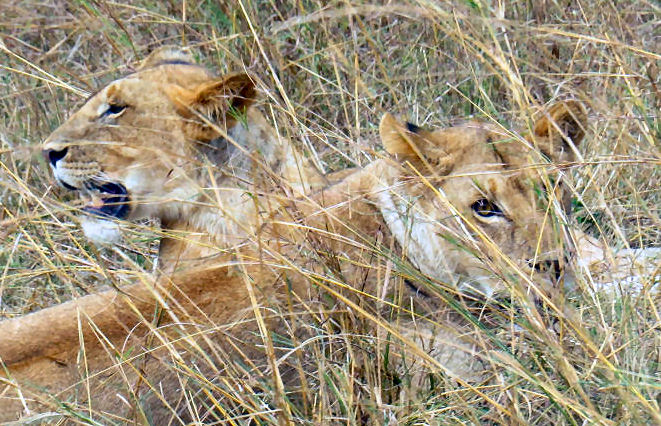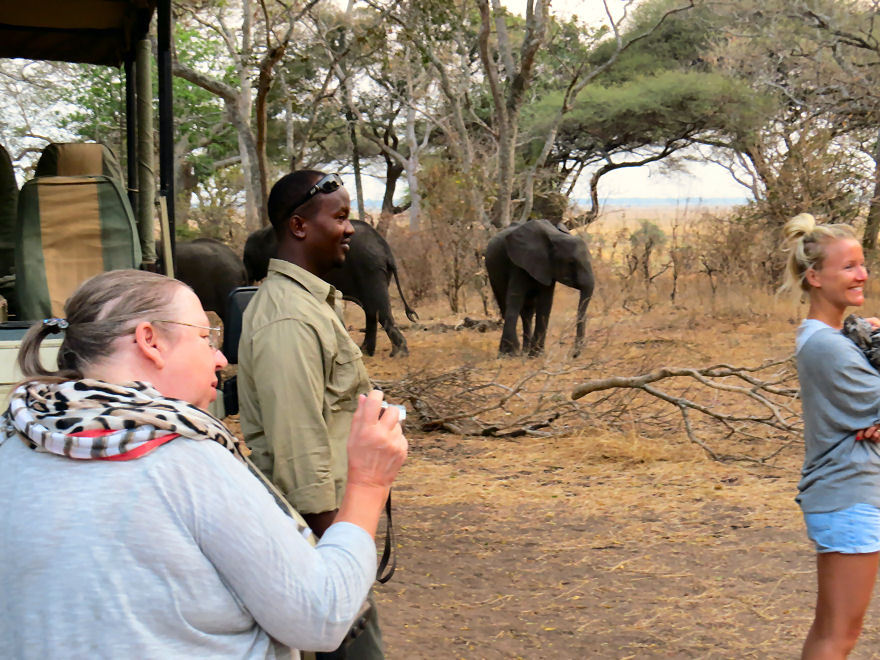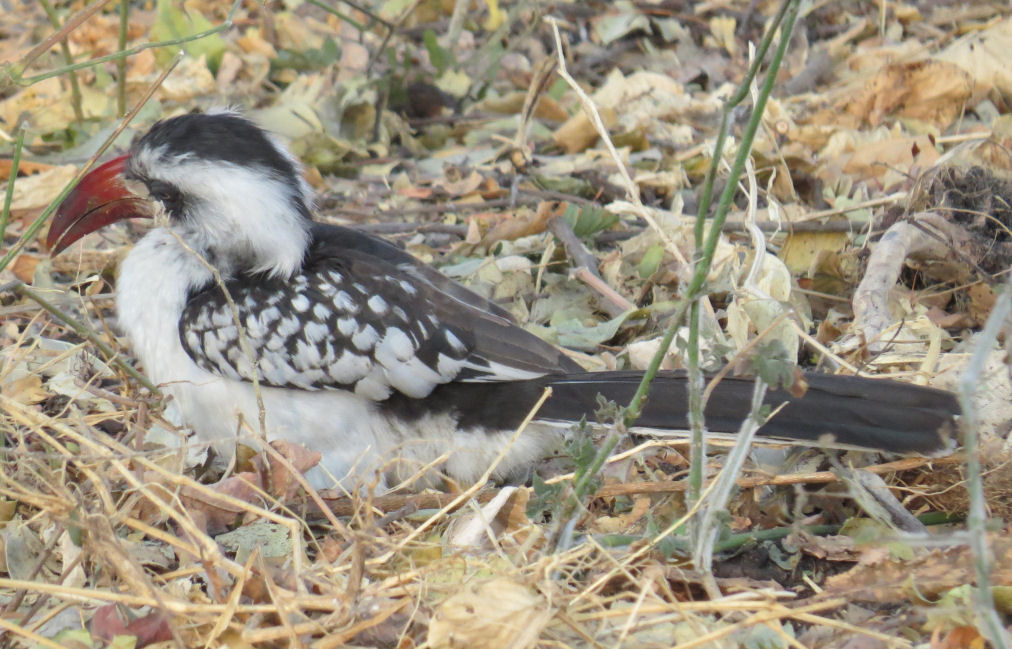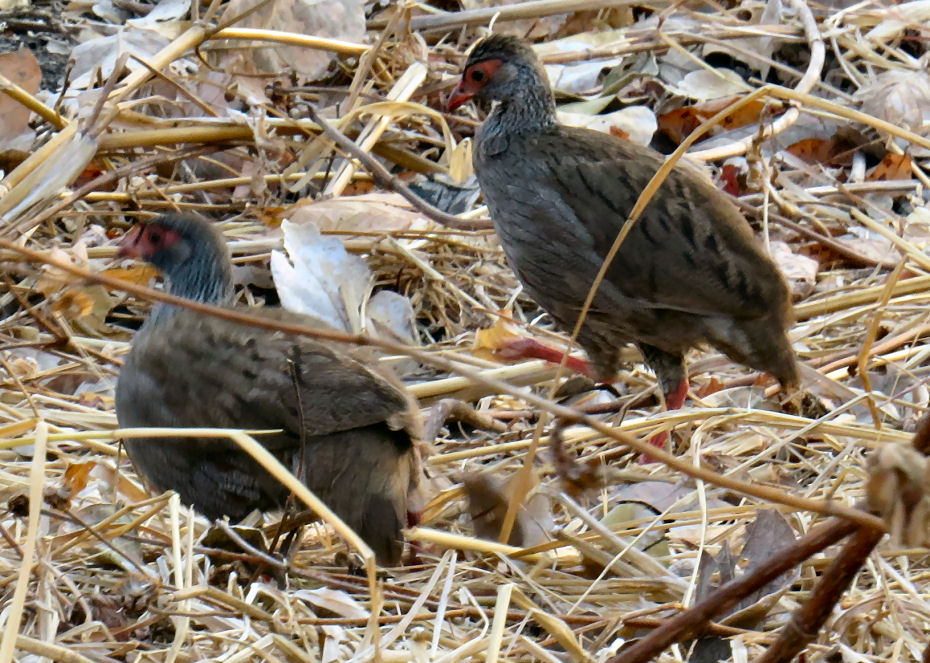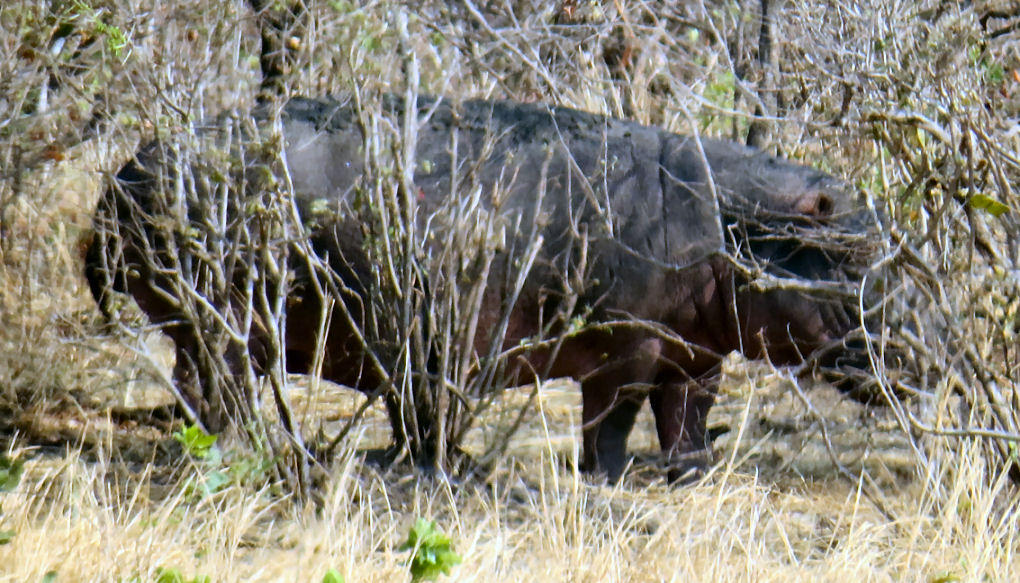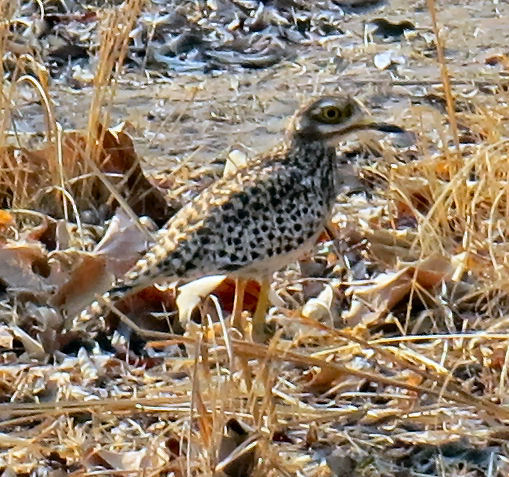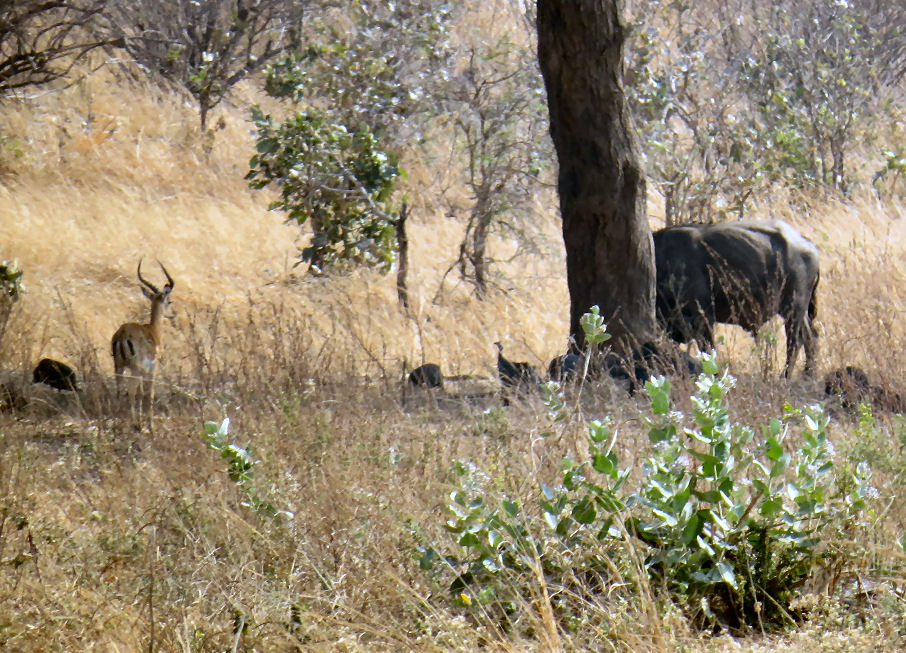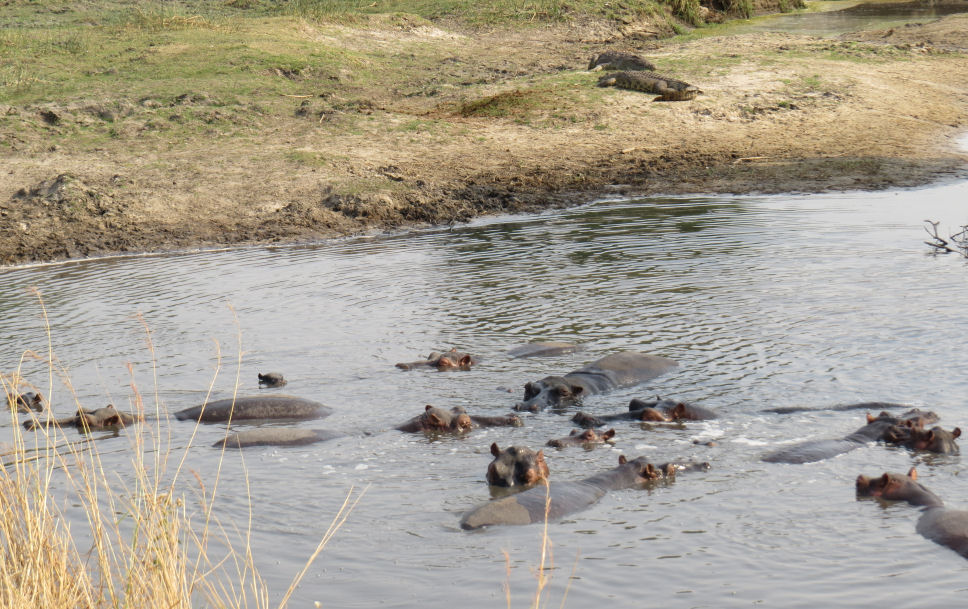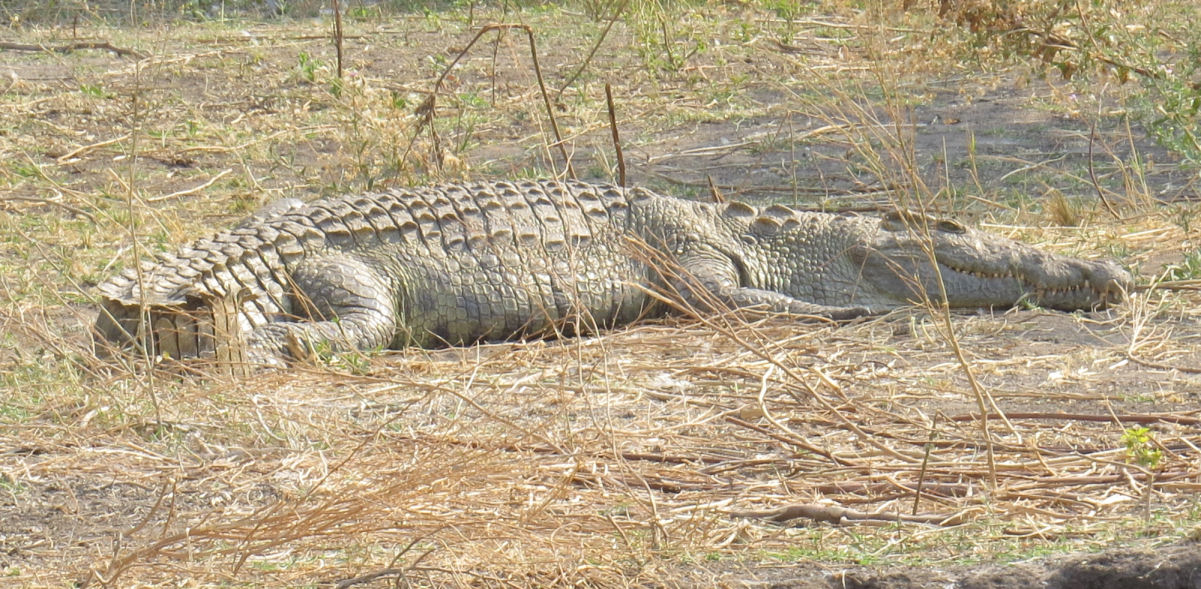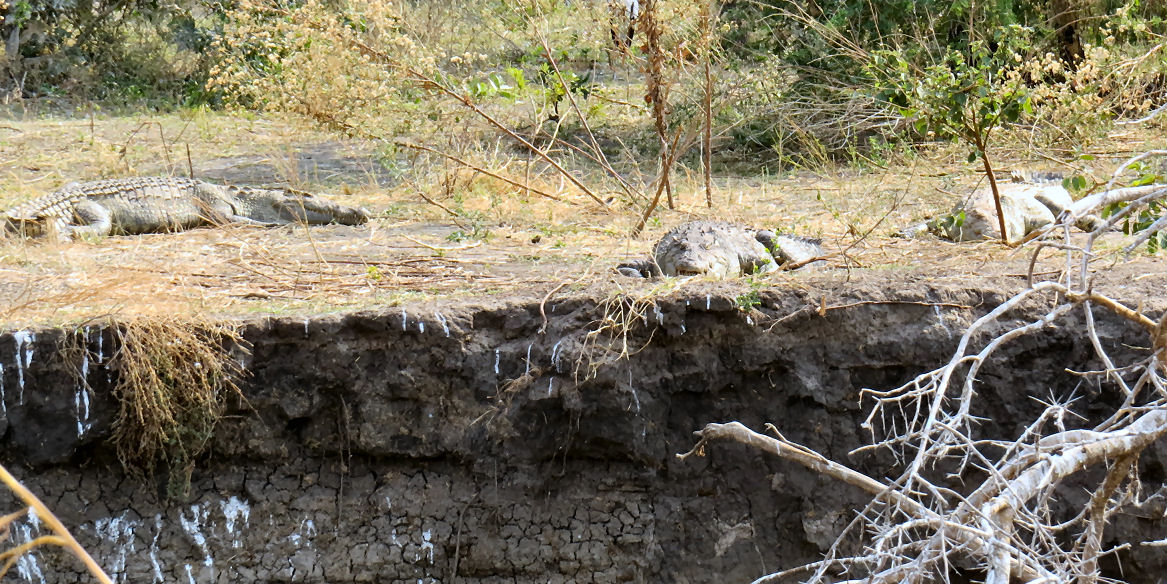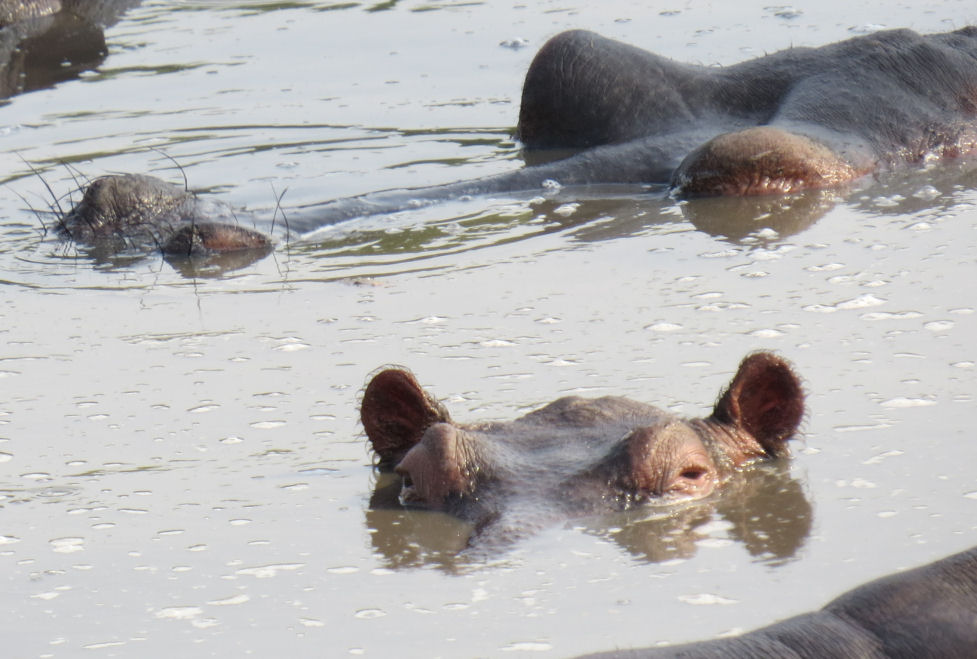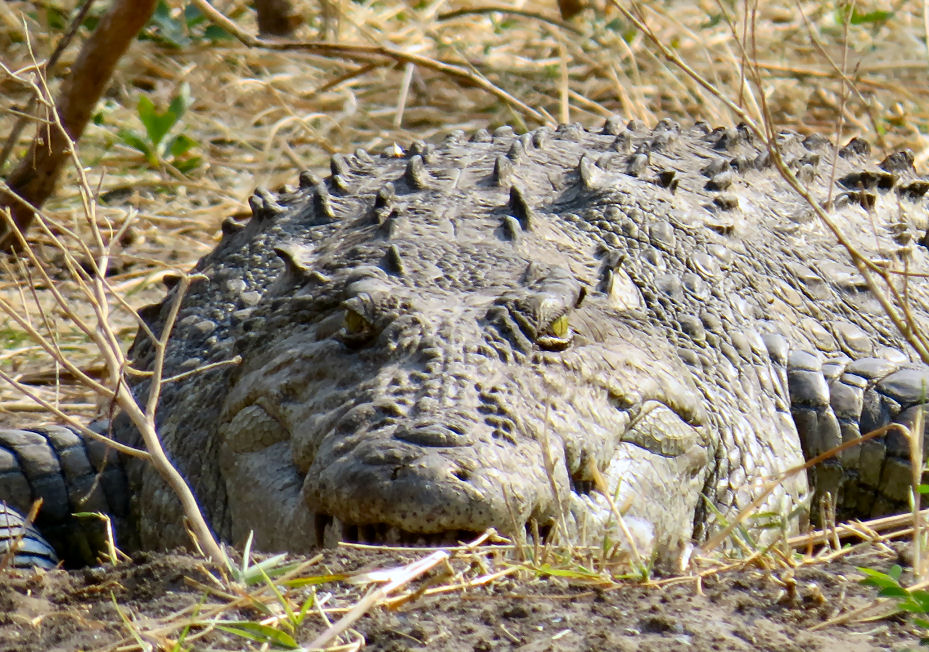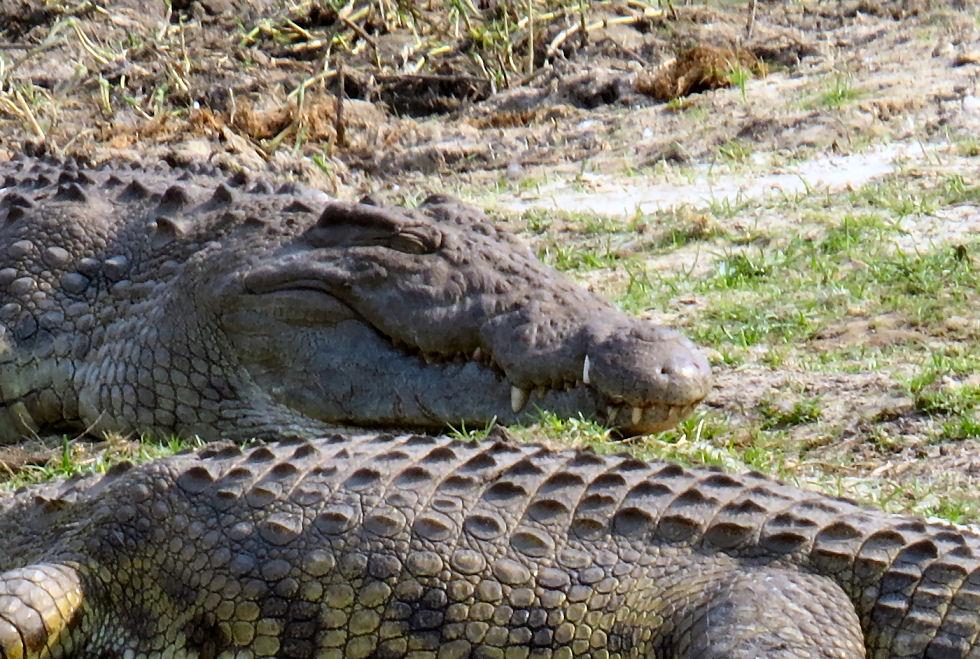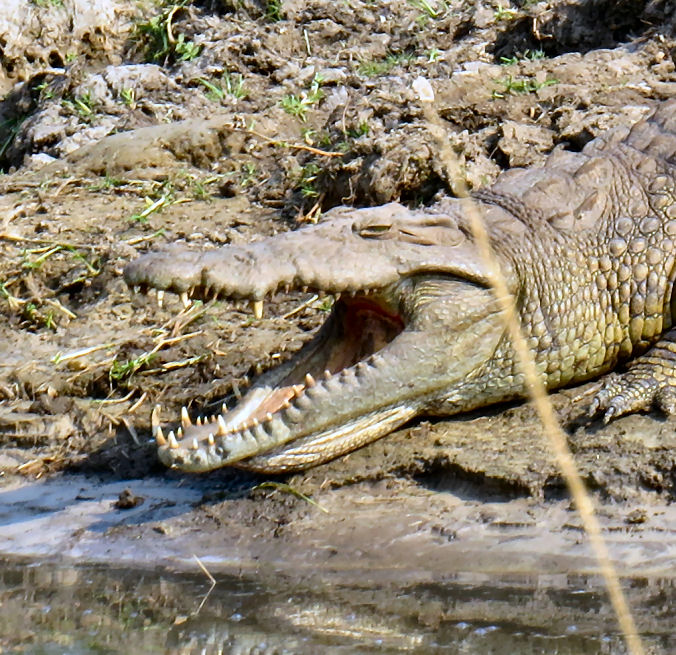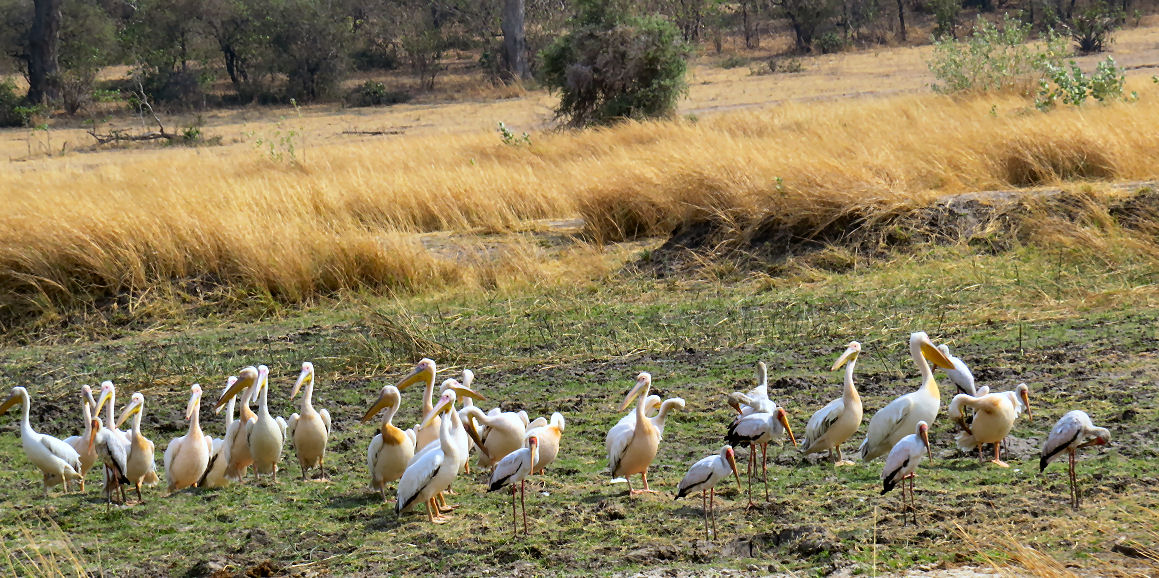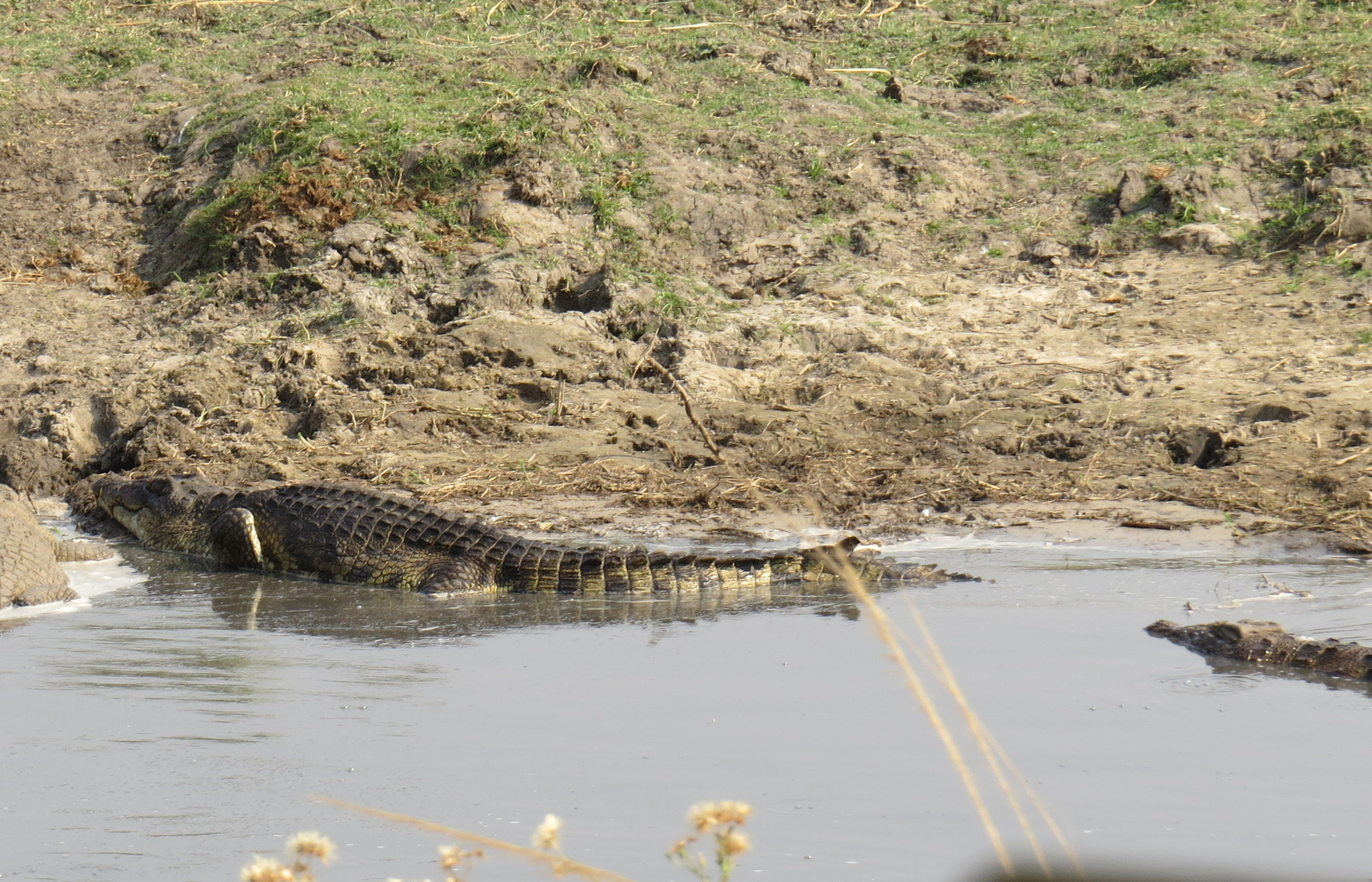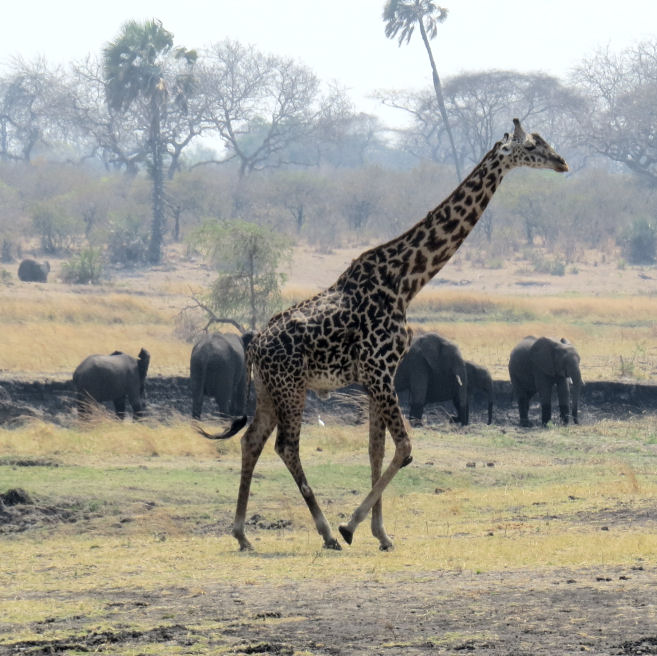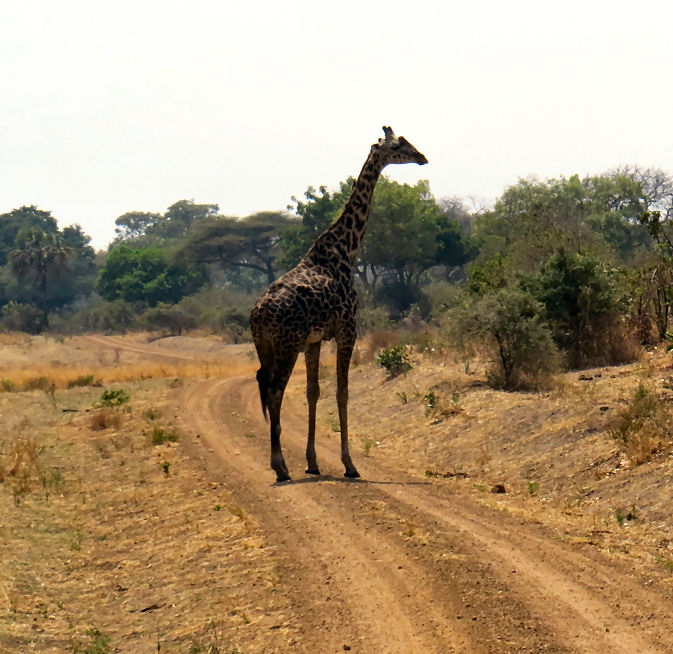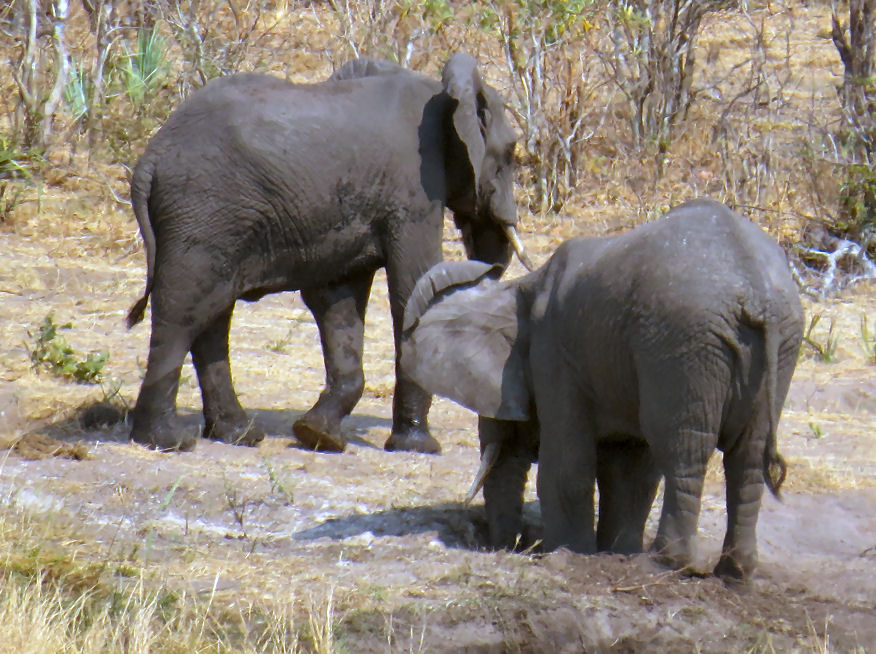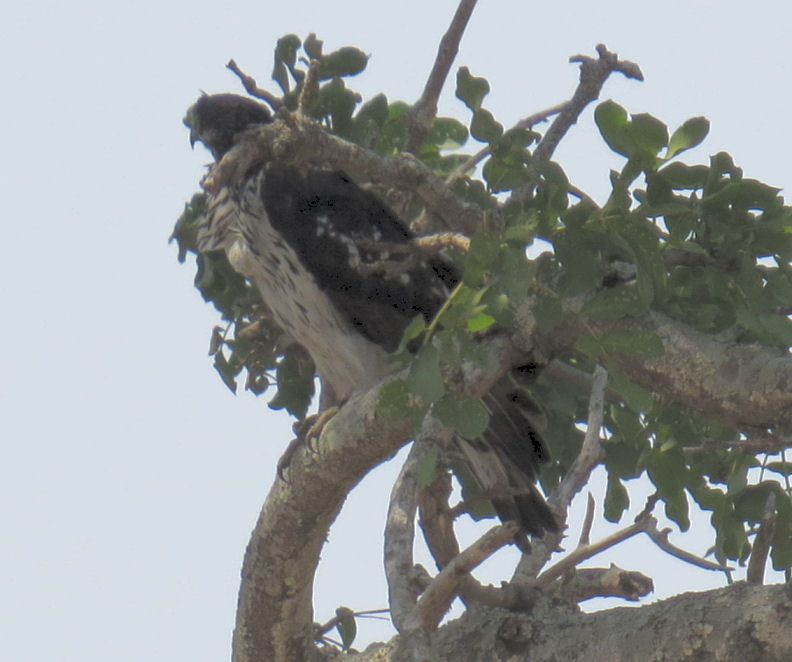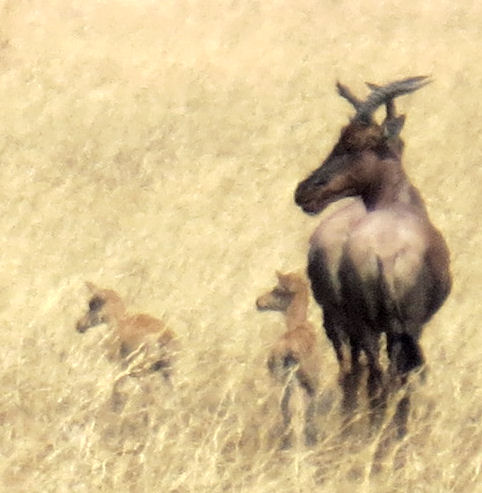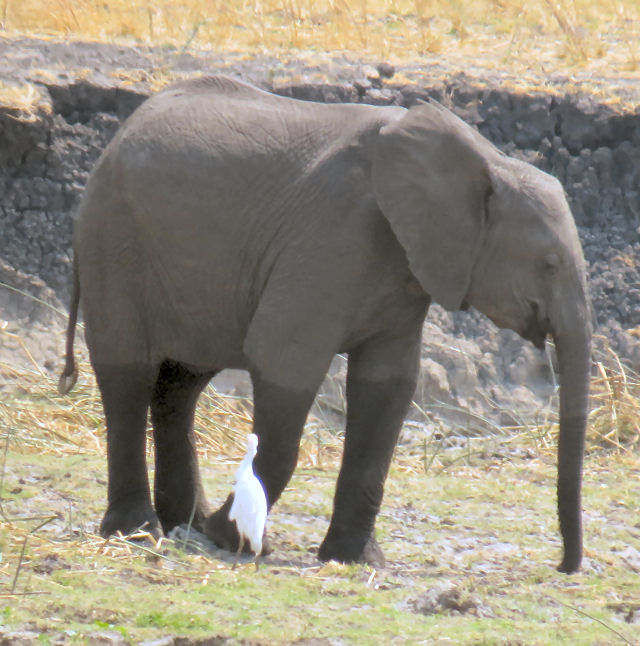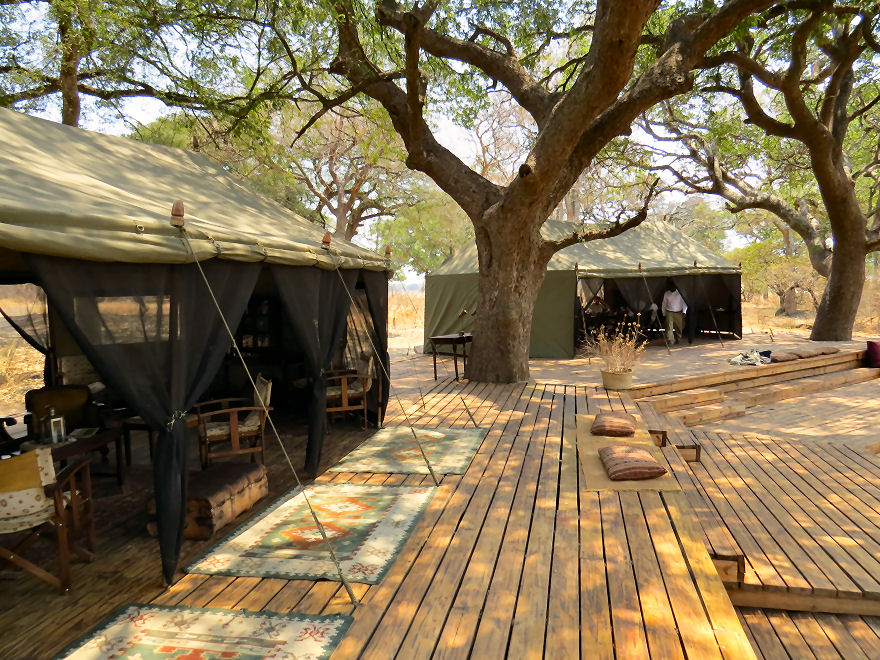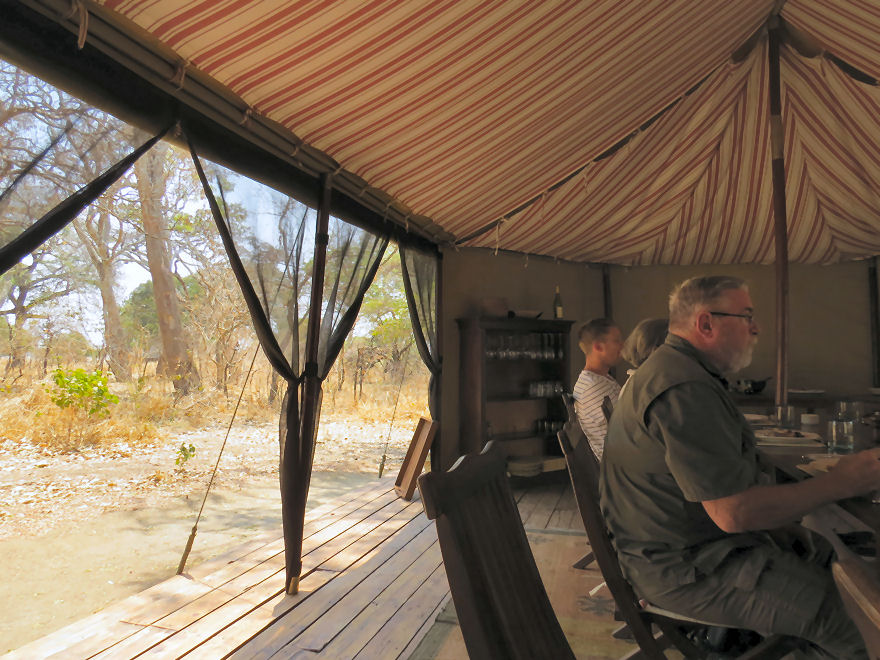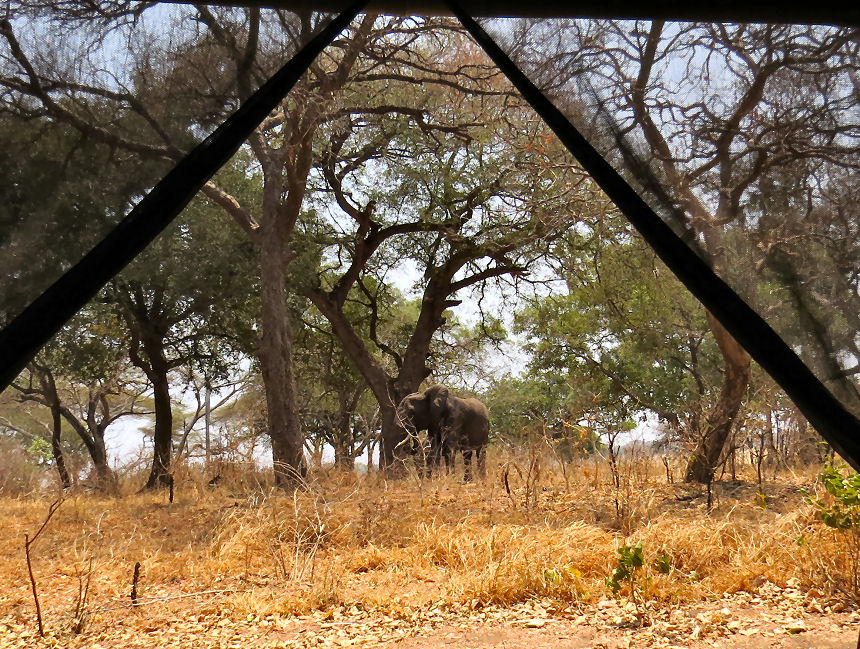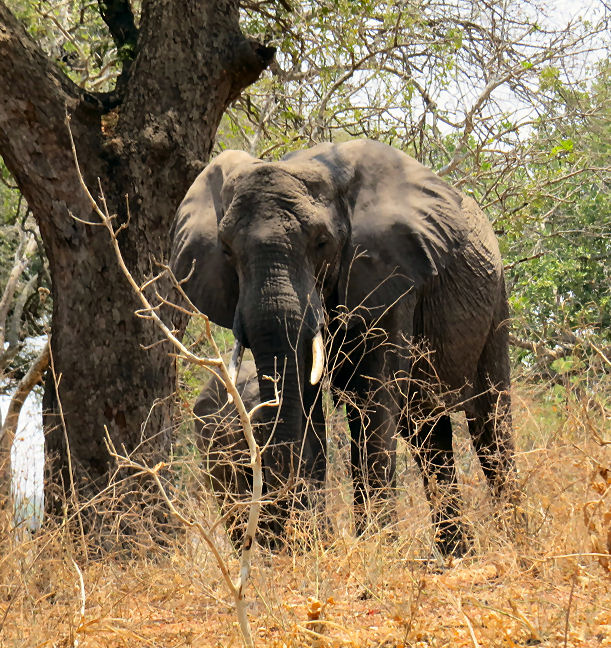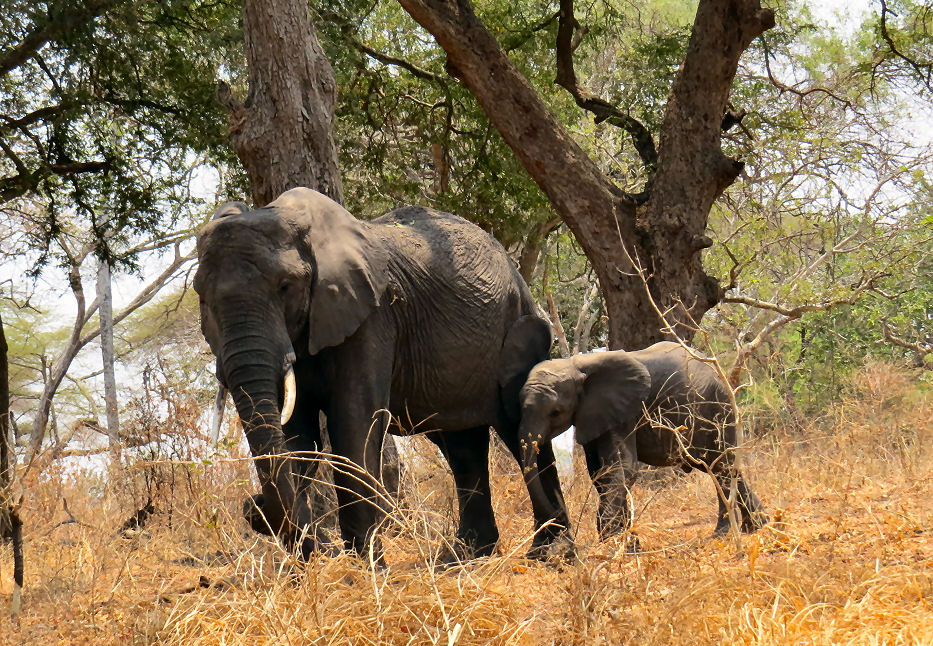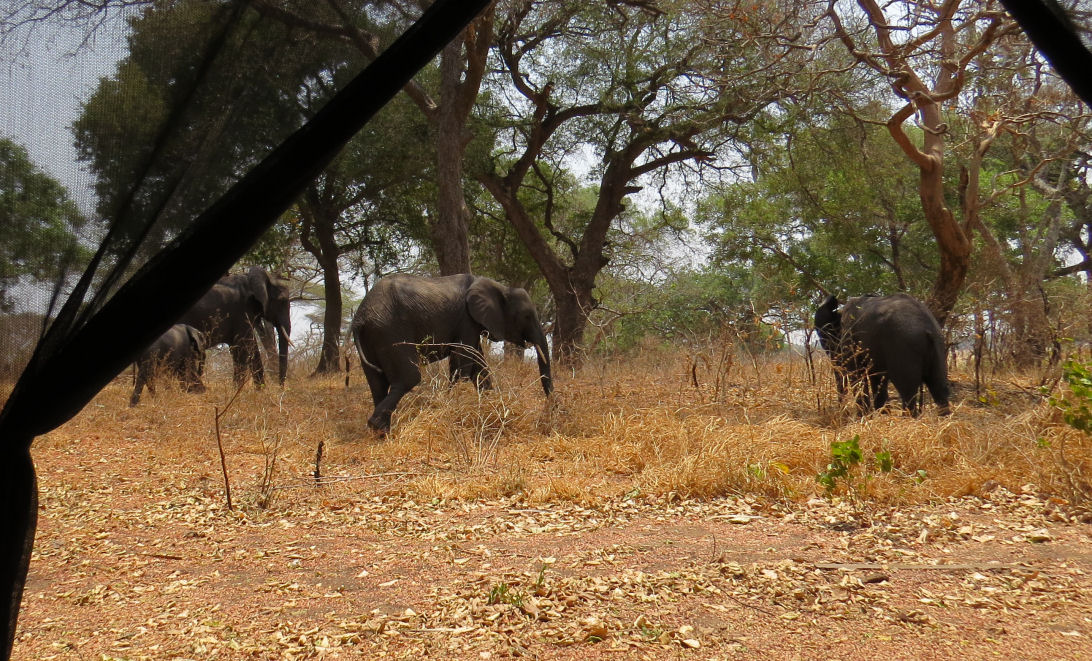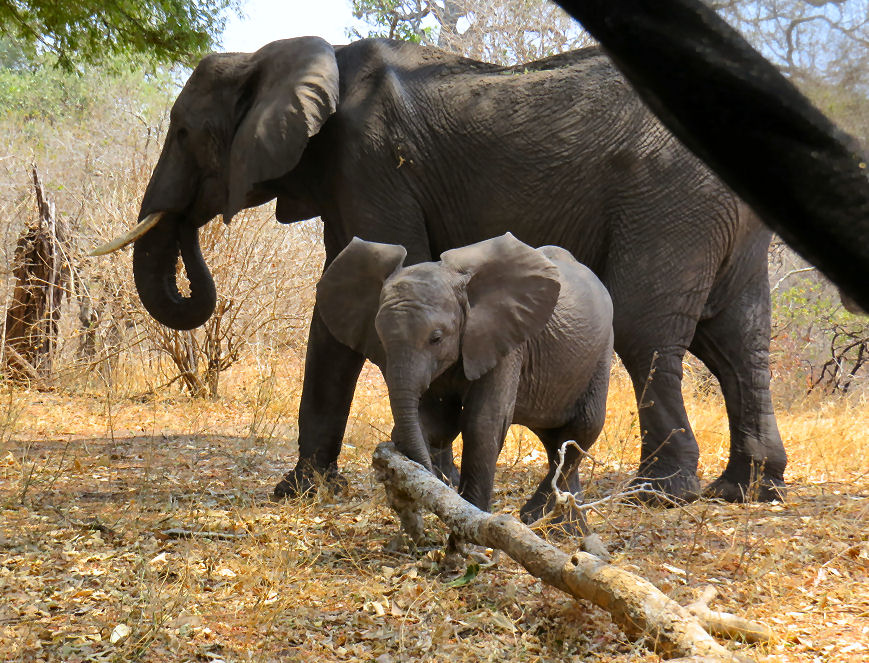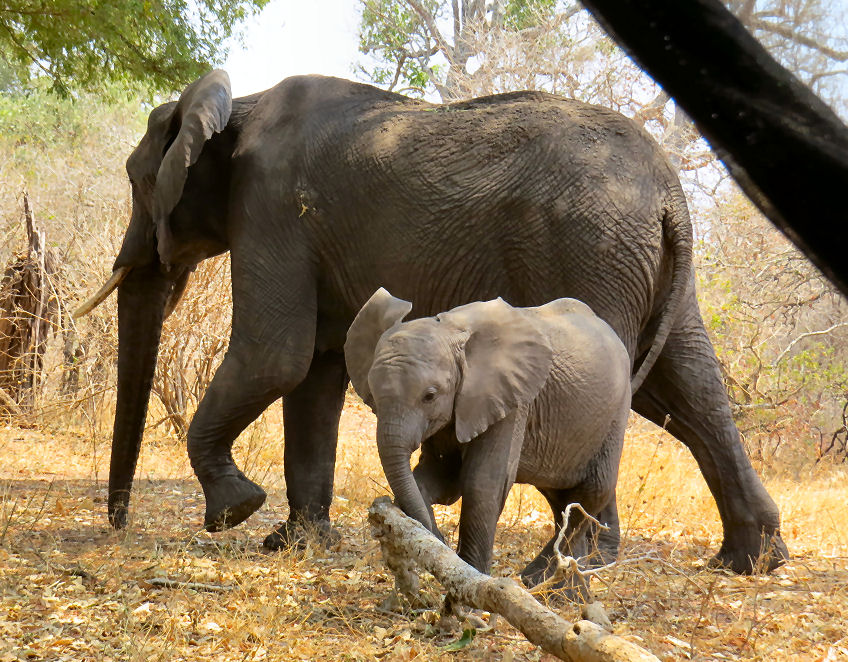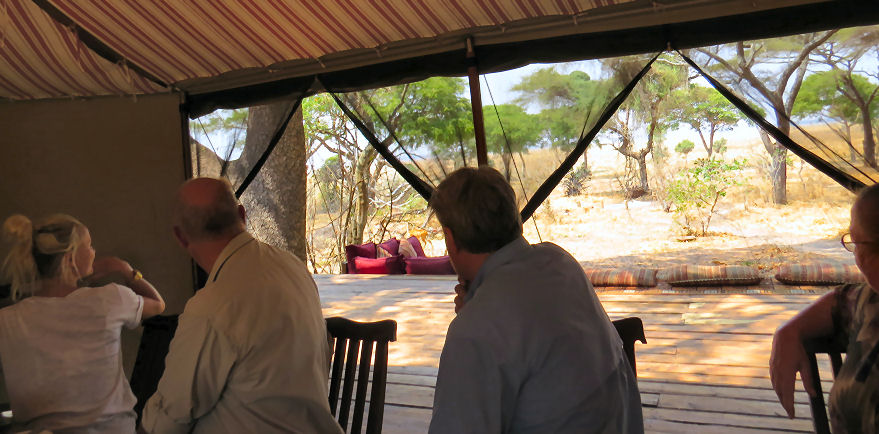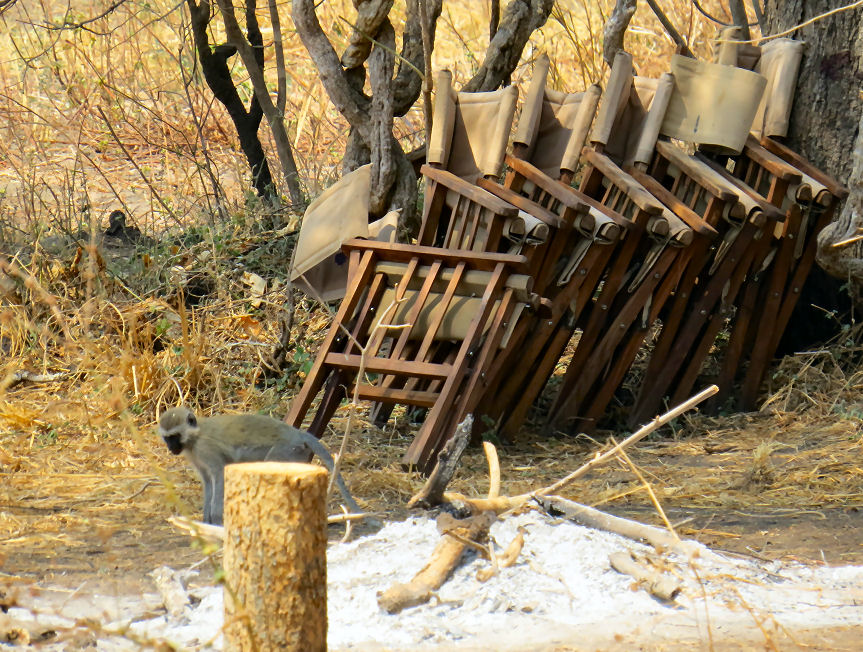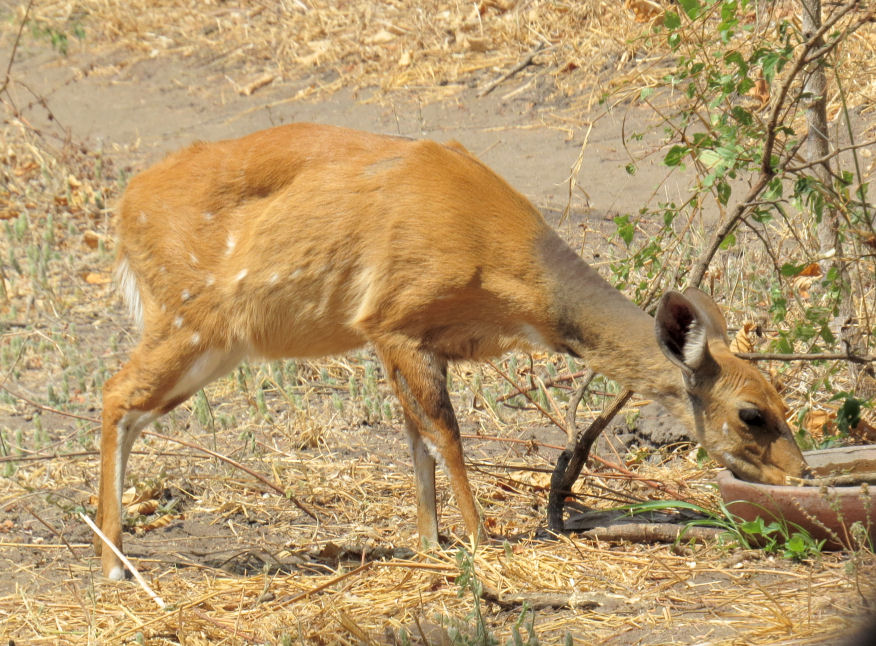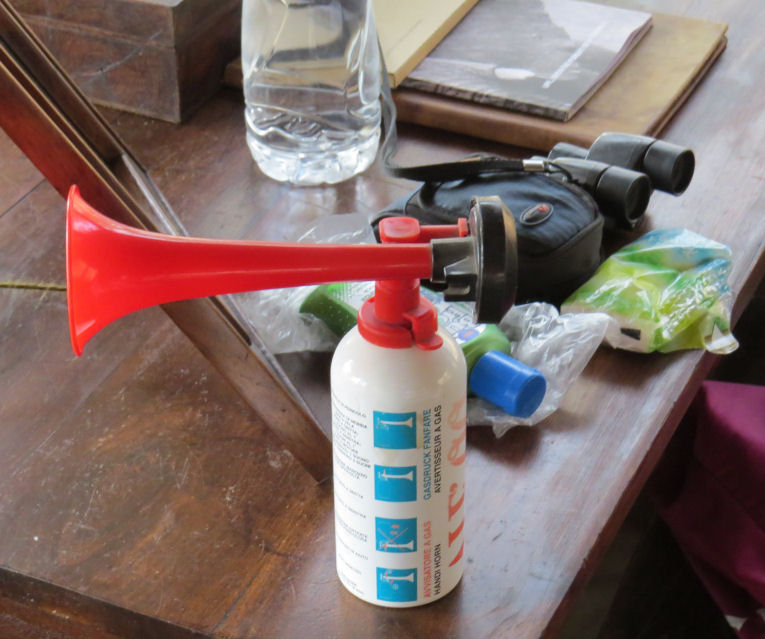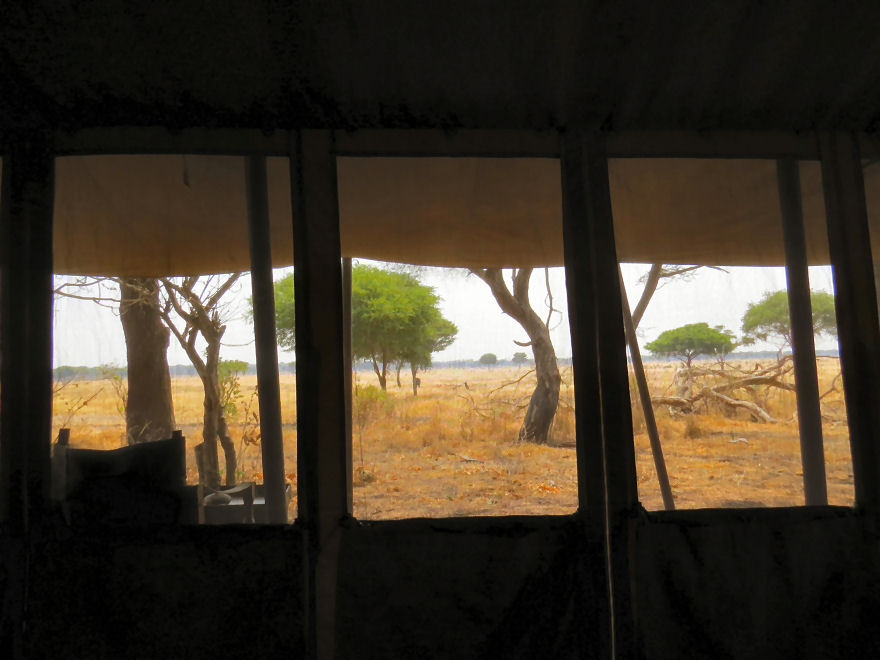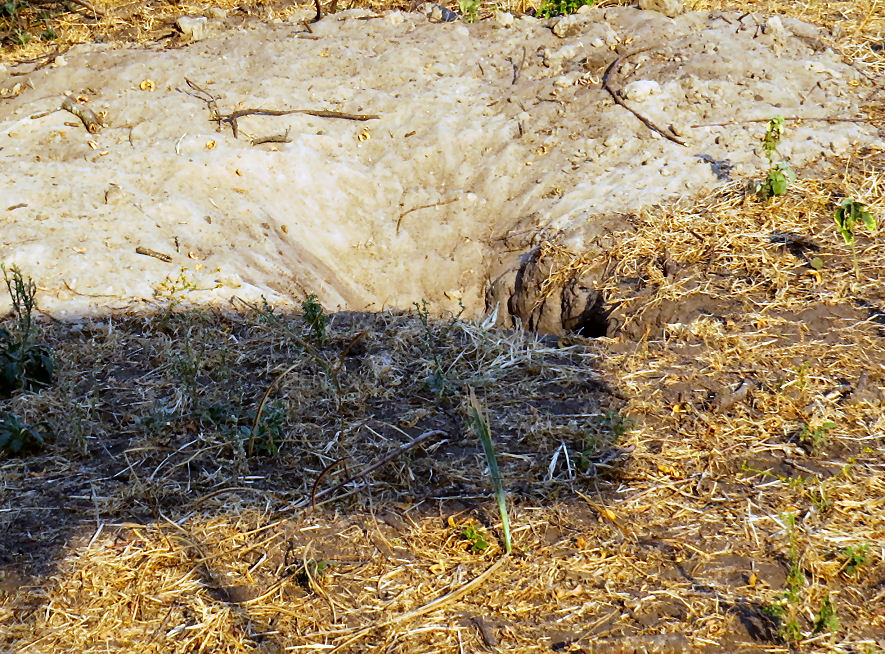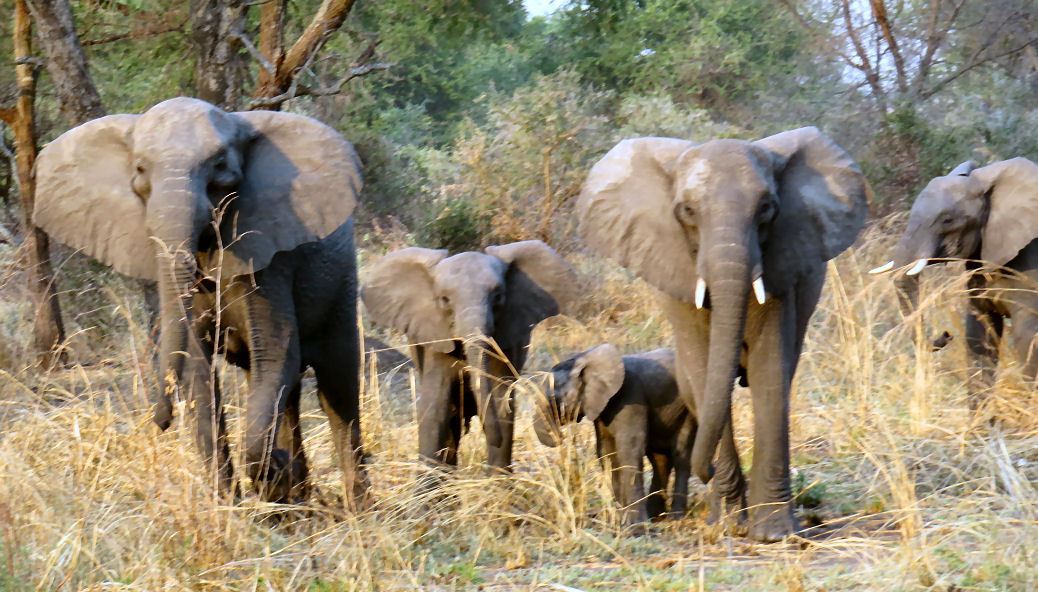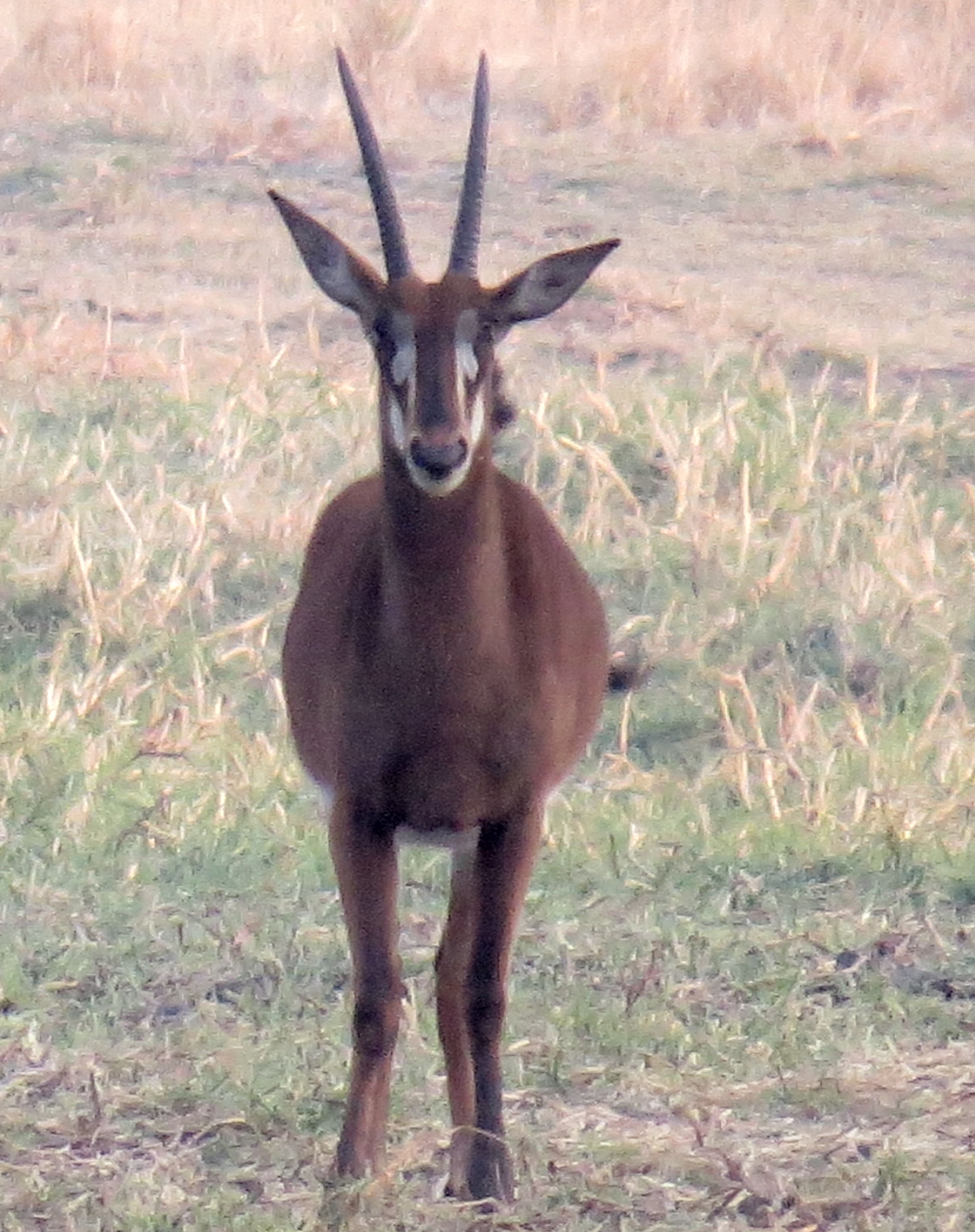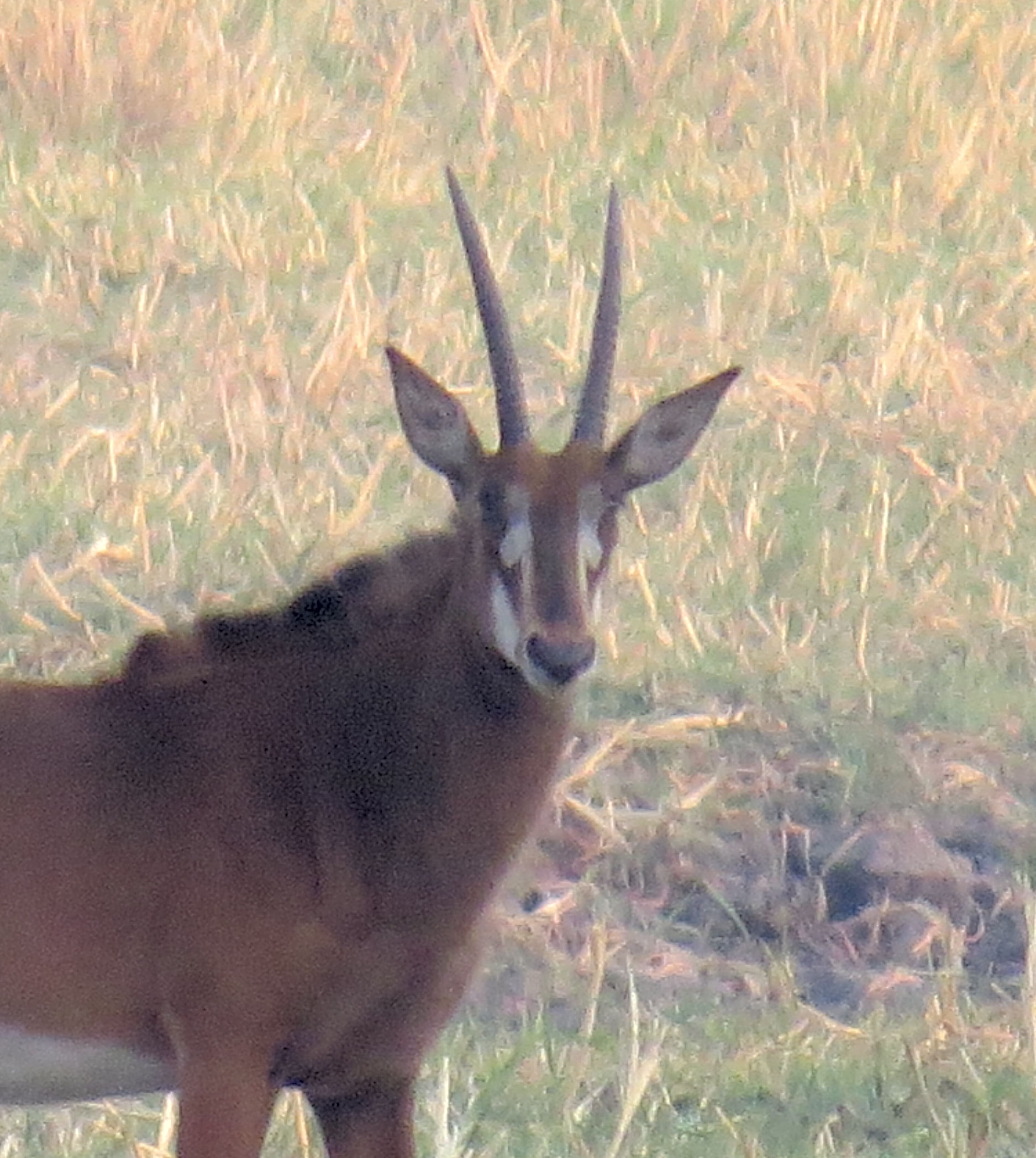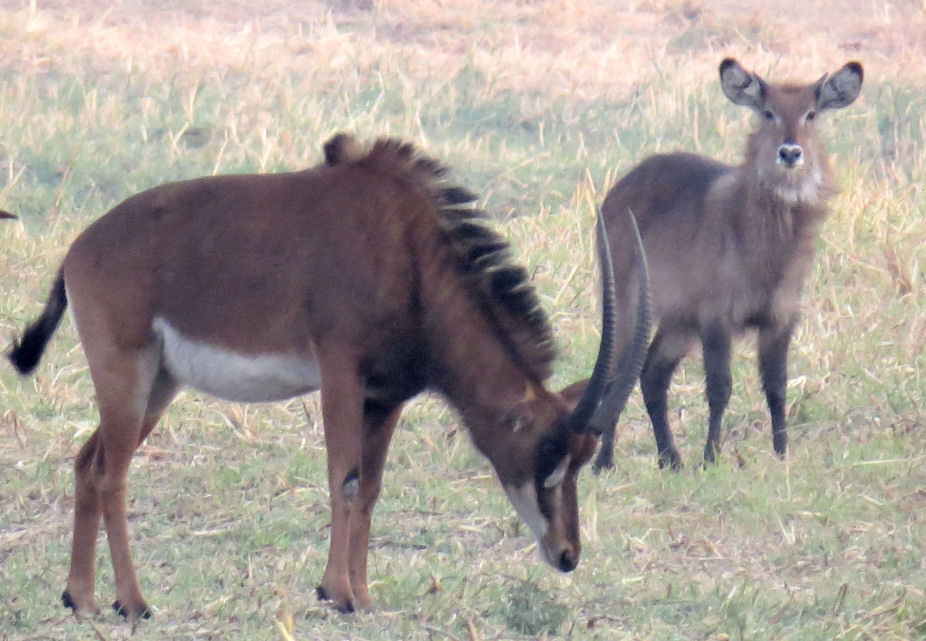Life in Katavi was, in some ways, decidedly more primitive than in the camp in the Serengeti. For example, the toilet in Chada Camp was chemical, whereas the one in Serian Camp was flush. The shower in the Serengeti had canvas walls and a roof. The walls in the shower in Katavi were made of sticks, and above was only sky. The appointments inside the common tents in the Serengeti were quite elegant. The ones in Katavi seem to be slightly less so.
On the other hand the pace of life in Katavi was much more civilized. We seemed always to be rushing in the Serengeti. The staffer brought us our coffee there at about 6:00. In Katavi we got an extra hour of sleep every day. Furthermore, because Chada was a permanent camp,[1] the public areas were on platforms, which made them quite attractive.
I had slept pretty well considering that I had done little besides sleeping throughout most of the previous afternoon and evening. Sue, on the other hand, was plagued by insect bites on her legs. I let her use the hydrocortisone anti-itch cream that I brought with me, but she eventually settled on spreading liquid soap on the bites and then letting it dry. She claimed that it worked wonders.
My mind on the previous evening had not been up to the task of remembering to take my Malarone pill, and so henceforward I had to remember to take them in the morning.
One thing that I definitely remembered to do was to place my clothes from Monday and whatever else needed washing in the laundry container. I pitied the people who had to deal with them.
I was considering skipping breakfast and even perhaps the morning game drive. I felt much better than on the previous afternoon, but I still had very little energy, and I had lost faith in my digestive system. The coffee and cookie revitalized me a little, and so Sue and I made the trek up to the common area together to check out the breakfast offerings. It was my first real view of the camp, and it was startling. When we reached the parking lot, several staff members were there along with Hannah. The staffers were there to prevent us from walking toward the breakfast tent. A family of five elephants was slowly parading through Chada Camp. Three juveniles were slightly to our left. The mother and a baby were to our right. All of them were busily munching on the pods of tamarind trees strewn on the ground. Overhead the monkeys were in motion in the branches. Occasionally one would tear off a pod and pitch it down to the elephants.

I retained enough presence of mind to return to the tent to get my camera. Sue asked me to get the point-and-shoot, too. As I began to return, one of the staffers directed me to a different path. The three young elephants had advanced to a point right next to the main path, and they were only twenty or thirty feet away.
I took a few photos of the elephants, but both groups were somewhat obscured by the vegetation. Then something startling happened. Tom, Betty, and Jeff were already in the mess tent, and they had already ordered their eggs and bacon. The waiter, evidently unaware of the presence of the elephant family, began walking from the kitchen tent to the mess tent to deliver a tray that contained the breakfast order. His path placed him directly behind the mother elephant.
The unexpected noise behind her and the waiter's bright white shirt startled the mother elephant. She went into baby-protection mode. She wheeled around 180 degrees, trumpeted, extended her ears to their full width, and began to charge. The three young elephants immediately galloped[2] over to join her. The waiter hurriedly set down the tray and then scurried back to the kitchen tent. The mother elephant stopped after a few steps, turned back around, and resumed scooping up the tasty tamarind pods as if nothing had happened. The three youngsters walked back to the area that they had so hastily abandoned.
Sue, Hannah, and I watched with undisguised awe. Needless to say, we were worried that the startled mother elephant might wreak havoc. The staff members who had been restraining us, however, could hardly contain themselves. They were bursting with laughter. They all knew that when an elephant spreads its ears as the mother did, it is only trying to scare someone or something away. If an elephant charges you with its ears back, you have a very big problem, but hers was only a mock charge.
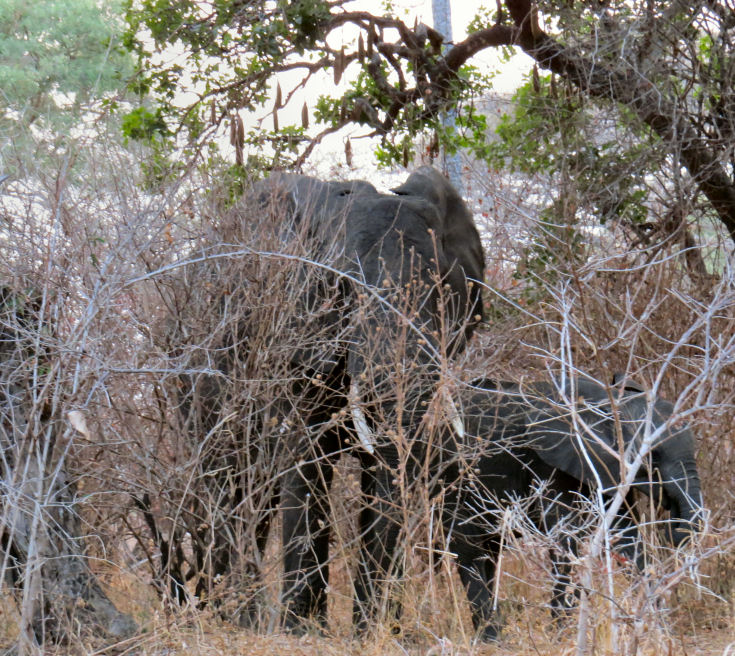
For another few minutes the elephants resumed their snacking. Eventually they had consumed their quota of tamarind pods, and they moved on. We had plenty to talk about that morning at breakfast. We met the other couple in the camp, Kirsten and Jan from Sweden. They explained how they had been trapped in the public toilet by the elephants. Jan had reportedly offered up Kirsten to them if they would spare the rest of us.
Jeff reported that he was about 90 percent restored to health. My percentage was lower, but I was pleased to hear that he was improving rapidly. I hoped to do the same.
Our game drive began at approximately 8:00. Molil's vehicle was a Land Rover, the first that we had encountered. Almost all of the safari vehicles that we had seen had been Toyota Land Cruisers.
I should mention that the dirt roads in Katavi were much smoother than in the Serengeti. Maybe it was due to the fact that there was much less traffic. Molil told us that there was only one other camp open in the entire National Park, and it did not have any tourists at the time. So we really did have the park almost to ourselves. We occasionally saw the other two couples from our camp, but no other tourists crossed our path.
The smoother roads made taking notes much easier. A high percentage of my notes from the Serengeti were illegible.
We spotted a red-billed hornbill, considered by Jimmy Durante to be the most beautiful of all avian species, a speckled mousebird, and a Wahlberg's eagle. I managed to shoot a photo of each of them.
I was experiencing a little difficulty with the camera's viewfinder. There was a small bluish distortion in it. I resorted to using the display screen for most of this game drive.
We saw a red-billed oxpecker. Molil told us that the yellow-billed was a little larger. We then saw two shrikes, a northern white-crowned shrike and a magpie shrike. Before this trip I do not recall ever having heard or read the word "shrike."
We saw a very large number of new birds on this drive. I was not always conscientious about recording all of their names.
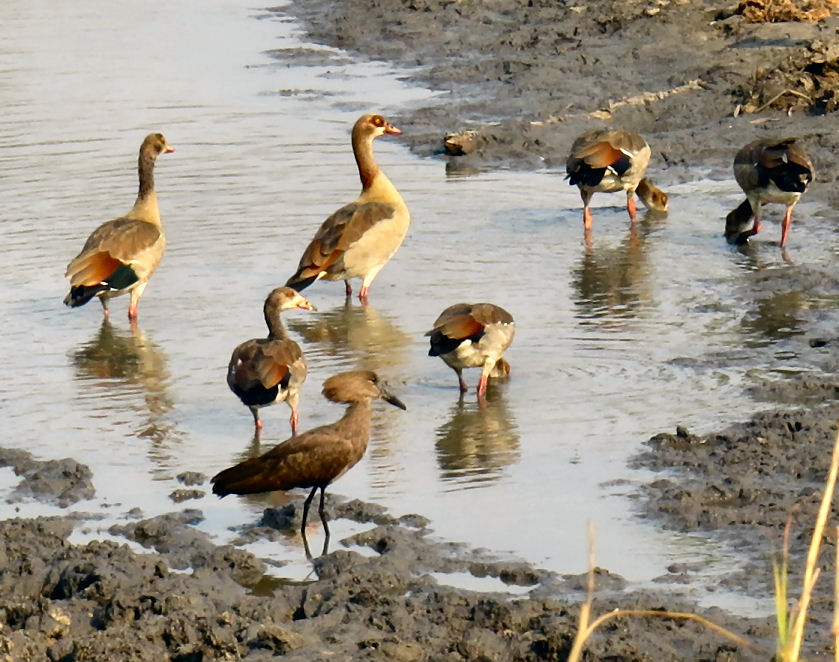
We had driven less than a quarter mile when the Land Rover stalled. Molil tried to crank it a few times with no success. Needless to say, Gerard's sentiments about Land Rovers from a few days earlier echoed in my mind. I wondered if Molil would be doing battle with this car for the rest of our time in Katavi.
Molil got out of the car and opened the hood. We could not see what he was doing, but he apparently made an adjustment to something and tried the ignition again. It still did not catch. He made a second adjustment, and this time the engine started up, and he resumed driving without ever cursing or even mentioning the incident. My fears were groundless; the adjusted Land Rover performed very well.
Our first sighting after the vehicle was again operational was a go-away bird. I did not take a photo, and I do not recall much about it. Nearby was an African monarch butterfly, which was even more difficult to photograph from a Land Rover.
Trees with long brown fruits surrounded us on all sides. Molil called them sausage-fruit trees. Their official name was kigelia.
Our destination was the Katuma River. On the way there we saw a few groups of impalas. Molil identified one as an alpha male with his harem. The other was a bachelor group looking for alpha males that were nearing retirement age.
We spotted a white-backed vulture in the vicinity of an elephant's skull. After that Molil identified a wattled something. I thought that it might be a jacana, but I wrote only "wattled" in my notebook, and the wattled jacana is a New World bird. "Jacana" is another word that I had never seen or heard before the trip.
We were surprised to see geese and other birds in close proximity to crocodiles. Molil informed us that the crocs do not eat birds.[3] It certainly was true that many of the water-birds of Katavi showed absolutely no fear of their imposing reptile neighbors.
Two bull hippos opened their mouths wide at one another. The aggressive display only lasted a second, and I missed what would have been a great shot. We stayed for quite a long time by the river enjoying the spectacle of so many hippos, crocodiles, and birds coexisting, for the most part, peacefully.
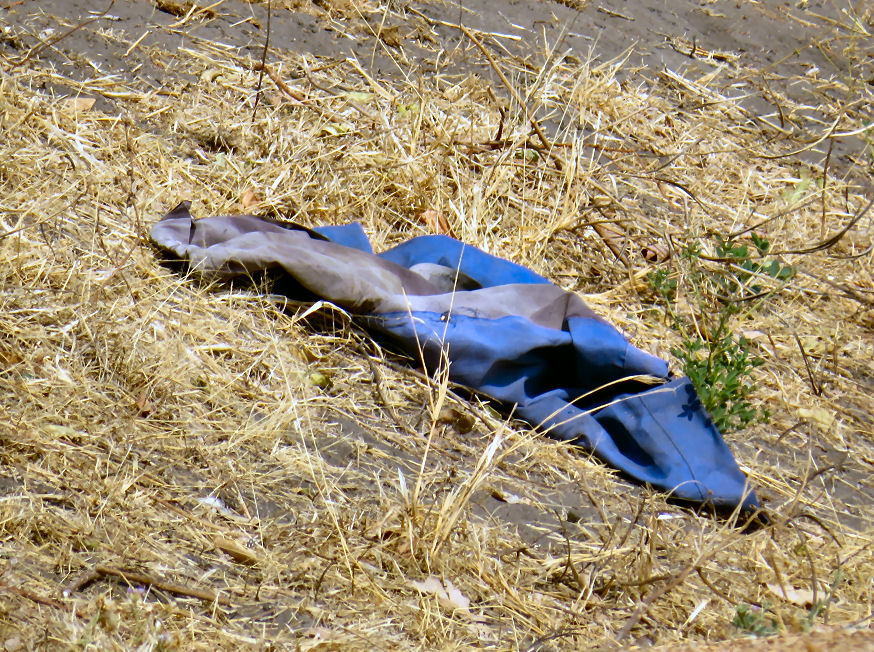
On our way back to camp we saw a large number of giraffes and some topis. We also caught sight of a grey kestrel.
We spotted a spotted thick-knee and an old bull buffalo.
We saw an injured impala buck that seemed to be acutely aware of a leopard in the grass. He stopped, looked intently, and then walked a little. He repeated this a few times while we watched. Nothing came of it.
We saw any number of birds, including a slate-colored boubou, a red-faced something (barbet?), and a collared sunbird.
Molil explained that the blue and black cloths that we have seen are set out to attract tsetse flies away from humans.
We watched a flock of great white pelicans land near the water. They mingled there with some yellow-billed storks.
Molil pointed to some yellow-winged bats, but I never saw them. I did see the African hawk-eagle perched high in the tree overhead. The branches made it difficult to pick it out.
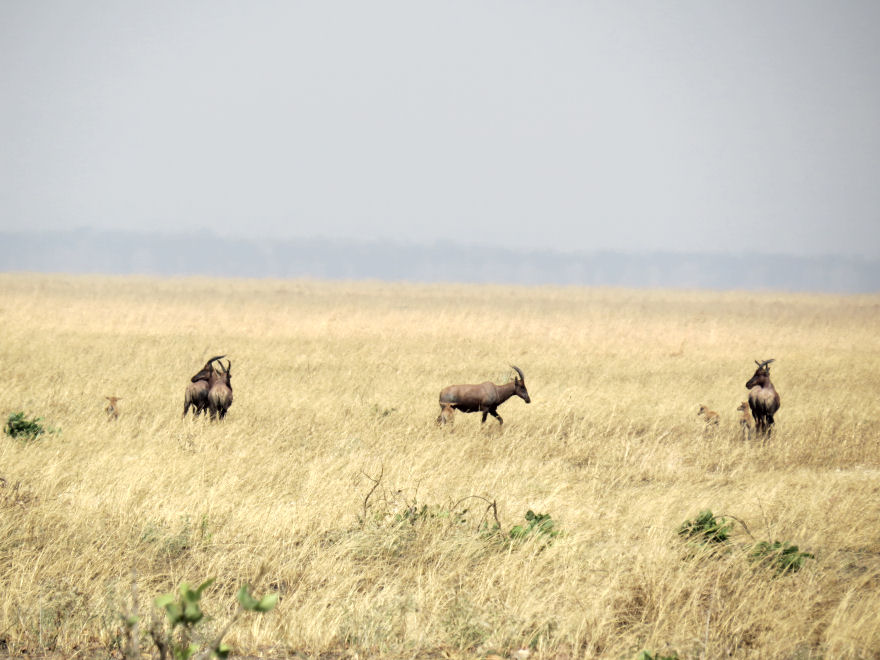
One of my favorite shots of the entire trip was taken from a very long distance. It showed a group of topis with their calves. For once the camera's focus was perfect and my hand was steady. I probably used the monopod.
A trio of giraffes glided in a stately manner across the road in front of us. We stopped and watched them for a few minutes.Our last stop of the pre-lunch game drive was to watch still another elephant and an egret that was not intimidated by the huge pachyderm's presence.
Lunch was at least as interesting as the game drive. Kirsten and Jan explained how they had been trapped in the bathroom by the elephant family led by the matriarch, who had been named Josephine by Julien, the manager of the camp. While we were eating, Josephine and her brood were clearly visible not far away. We also had another visitor, a bushbuck named Rogerina, who was another common visitor. She liked to drink from the birdbath.
Julien disclosed that the other staff members had teased that morning's waiter mercilessly. Julien told him not to worry about the eggs if it happened again. Just get away from the elephant.[4]
I also learned that Matt had planned the entire African honeymoon, and every new feature was a surprise to Hannah. We learned that we would be flying together to Mahale in a couple of days, but Hannah supposedly was ignorant of this even though Julien spilled the beans several times. She also did not know that she and Matt would be spending the night fly-camping out in the bush. I was not quite sure what this entailed, and I vowed to ask them about it afterwards.
As usual, I read a little bit and napped a little bit during the break.
Before the afternoon game drive began Tom reported that he spotted a business of banded mongooses scampering near his tent. Rogerina the waterbuck was also seen at the birdbath near the campfire.
On the way to the huge open savanna we were able to see a herd of buffaloes that was accompanied by some zebras and topis.
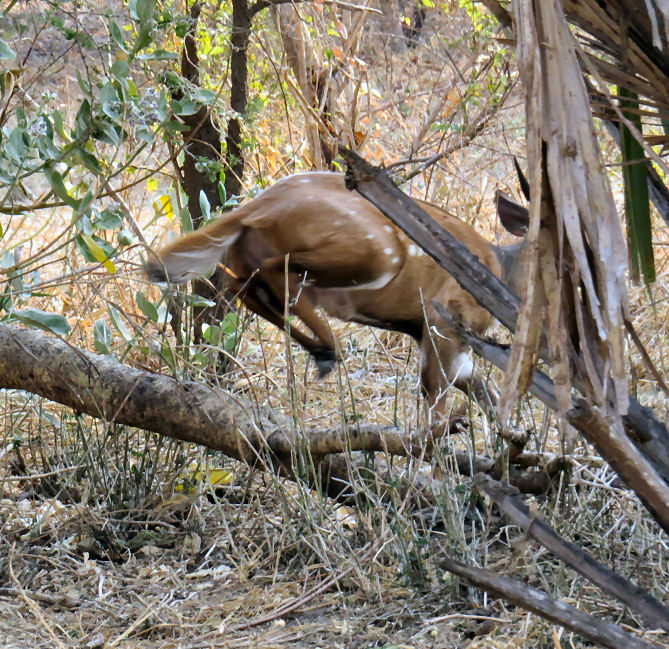
We saw a male bushbuck, but my camera decapitated him. I have subsequently named him Robespierre. Molil showed us some hippo trails. The hippos mark their paths with their scat, of which they produce an enormous amount each day.
Two new birds were added to the list — a collared palm thrush and an emerald-spotted wood dove.
There were two highlights of the afternoon drive. The first was when Molil spotted something in a tree. It was a savanna monitor lizard that was barely visible at all. Shortly thereafter he saw a rock python curled up in a different tree. The python was only slightly easier to locate.
Molil showed us a hole that was the remnant of a termite mound after an aardvard had decimated it. We were excited to hear that there were aardvarks in the park, but Molil said that they only came out at night, and they were almost never seen, even on night drives. Betty was nevertheless confident that she would be the one person in a thousand who got to see one.
We came across some more mongooses and a family of elephants. The matriarch had somehow lost her tusks. Perhaps she had gingivitis.
The second noteworthy sighting occurred in a very long peaceful savanna. Numerous zebras, giraffes, and antelopes were visible, but Molil spotted something unusual a great distance to our right. By using his binoculars he could tell that one group of antelopes had horns with a distinctive backward slant. He was pretty sure that they were roan antelopes, a new species for us.
We took some photos, but they were a very long way away. I doubted that even Jeff got any good shots. Molil drove closer. We took some more photos. Molil drove closer. More photos. We could now see that a bushbuck (or something) was attempting to pass as one of the roans. We drove closer still, and I was finally able to get some pretty good close-up shots of these beautiful animals. Jeff's were probably even better. He had better equipment, and he knew what he was doing.
We took some photos of the sunset, but they did not measure up to the ones on the Serengeti.
The campfire was quite intimate. Matt and Hannah were off fly-camping. Julien told us about the camp. I do not remember very much about the conversation at supper. I was probably self-absorbed, content in the knowledge that I had made it through the entire day without much difficulty at all.
At supper I had a unique opportunity to answer a question that has nagged me for forty-five years. Julien said that he was learning Swahili. I asked him if Swahili had infixes. I had to explain to him about prefixes, suffixes, and infixes. Once he understood the question he affirmed that, although he had not gotten to that lesson yet, he was sure that infixes were a feature of the language. He was right. Check this out.
[1] Nevertheless, it closed during the rainy season.
[2] Elephants can run roughly 25 miles per hour. They could not catch Usain Bolt in his prime, but they could definitely outrun anyone in our group.
[3] This, I have subsequently learned, is not quite true. I surmise that where other game is prevalent, crocs prefer fish and other creatures. Birds do not contain much meat for their size. Many are mostly feathers and hollow bones. However, very hungry crocodiles would likely be less picky.
